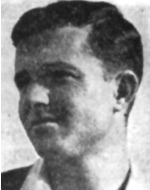Persitz, Benjamin
Son of-Nechama and Yitzhak, was born on March 18, 1924, in the city of Kursk, Russia, and immigrated with his mother to Israel in 1929 (his father, one of the exiles in Siberia, preceded them). Benjamin attended the Tachkemoni elementary school and the Hebrew Gymnasium in Jerusalem and excelled in his studies, especially in mathematics. He was a member of the Scouts movement and completed his studies in 1941. He served in Kfar Giladi, Dafna and others until 1944. He was among the most active in the “Black Job” as they called for the transfer of immigrants from Syria. The British Intelligence and the British Army searched for him and his name and picture fell into their hands, and he was forced to go down to the underground for a long time, and was accepted to the Hebrew University of Jerusalem and studied natural sciences and prepared to travel abroad to study law. Who served in the Palmach, took part in the “Wingate” operation at a post on Yehuda Halevi Street, during Operation “Night of the Railways”, in the explosion of the railway between Jerusalem and Betar, In the explosion of the Allenby Bridge on the Jordan River. He had to put explosives on the eastern end of the bridge. His composure in this action surprised even his friends who were not at all comfortable to panic. With the increasing tension in Israel, he changed his mind to go abroad and was accepted to the Faculty of Chemistry at the Hebrew University, where he studied for only a few weeks. With the outbreak of the War of Independence he returned to join the unit, participated in battles in Sha’ar Hagai and accompanied the convoys on the Tel Aviv-Jerusalem road. His Palmach company, which was based in Maaleh Hahamisha and managed the battles at Sha’ar Hagai, carried out daring missions to burn out the gangs in the area, and his friends say: In two things, Benjamin stood out during this period: a) When the soldiers were exhausted, (B) As soon as he returned to the base, he would shower in cold water, change his clothes, and reappear as if he had not had at all 20 hours of uncommon labor and exertion. Despite his vigorous opposition, he was forced to accept this role, but he made an explicit condition that no He was one of the members of the “Halachah” (“the Mountain Division”), Palmach and Hachash fighters who were sent as reinforcements to Gush Etzion after the large attack on the Gush on January 14, 1948, after he insisted that he be attached to the platoon . The fighters left Hartuv on the night of 15-16 January and were loaded with weapons, ammunition and equipment, but due to the late hour of departure and the difficulties of the road, they could not reach Gush Katif in the night. At dawn, the department was discovered by villagers in the area of the villages of Beit Natif, Jaba and Surif, who called the Arabs of the area to the area and surrounded the department. The fighters organized themselves on one of the hills (the “Battle Hill” today) and fought with the masses of Arabs until they all fell in battle on January 16, 1948. Binyamin was buried together with his friends in Kfar Etzion on November 17, 1949) was transferred to rest with the rest of the Bloc in the military cemetery on Mount Herzl in Jerusalem.
